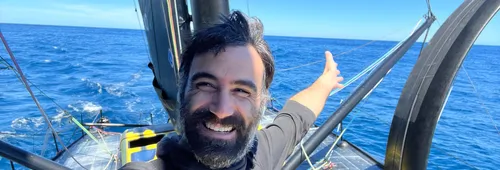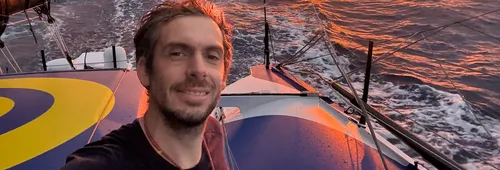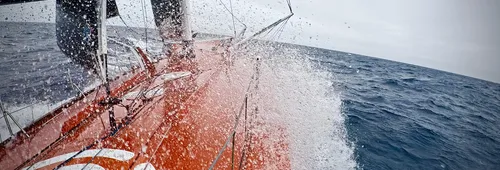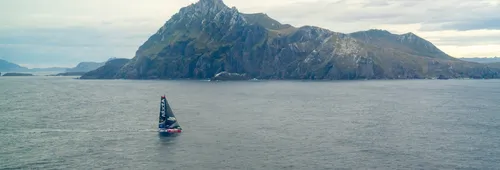Benefiting from their choice a couple of days ago of moving a little more south Sam Goodchild (VULNERABLE) and Yannick Bestaven (Maitre Coq V) are moving well against the boats to their north. Brit Goodchild has passed Nico Lunven (HOLCIM PRB) and is threatening Jérémie Beyou (Charal).
Goodchild and Bestaven are enjoying the respite after the big low which has focused the leaders minds these past days and he is up to sixth, only a few miles behind Beyou. He took the time to update on his recent spell dicing with the big low,
SLEEP IS THE KEY
Like most other skippers he has found it harder when he is under slept,
“Morale is linked to sleep. When I manage to get some good sleep I am appreciating the Vendée Globe, the race, the conditions, the boat, everything and when I can’t sleep like in the heart of the depression it was pretty difficult to get some rest when conditions were so unstable and the waves so big and unmanageable the tunnel seemed so long with no light at the end of it. But I am on a high now with a nice gentle night with 15knots of wind, fairly stable. I managed to get a couple of good, hour long sleeps in. Good quality sleep has changed my life and I am very much enjoying life. And as for the boat, the boat is on good form, I am trying to keep an eye on her as much as I can, making sure I don’t miss anything. The most touchy thing is the rudder system. I have had to stop a couple of times to try and fix it and keep on top of it. At the moment it is OK. I fixed the bearing problem, I fixed the down line problem. And so I just keep an eye on it and make sure it does not get any worse. Otherwise the boat is in quite good shape.”
The most important thing to Goodchild has been setting his own pace, sailing his own race,
“In the heart of the depression when the seas were five or six metres the boat was quite hard to manage, the boat wants to take off on every wave and there is a huge car crash at the bottom of each, and you go from 35 to 10 knots and be under water, and then the whole thing starts again and so the idea is to have a decent average speed and avoid that. That was difficult and it is worse when the wind is unstable it is so much worse. When you have found a setting which works and then the wind drops and you are not going forwards as you should then it is hard to find the right balance. The more the wind was up and the more unstable it got then the harder it got. The one thing there is how stressful it is when then boat surfs at 35 knots and the boat slams down a wave and the whole boat goes under water, that is worrying in terms of breaking things, and then the other part is living on board, sleeping in these conditions – one second you are pretty much standing on the bulkhead in front of you – and it leans over and starts slamming, getting some sleep was pretty much impossible.”
Conditions are manageable now,
“We now have two or three metres of waves so we are surfing them and it is a lot more reasonable. So far I have been quite successful in the way I sail the boat and not looking at anyone else and saying ‘look, he is going fast, or look, he has gybed, so I am just sailing my own race. I have five weeks in the south, 11 weeks overall, it is a long race, and I feel like I just need to be in harmony and a bit in your comfort zone in how you push the boat, and so I am working on that, being in my comfort zone and not pushing myself further than I want to be, and sometimes I gain miles, sometimes I lose miles and that is part of the game really, I’ll see what happens with Nico and Jérémie, of we end up in front of them, then it is not going to change the way I sail as it won’t if I end up behind them.”
“The next days to come there is another depression coming through which is not as big as the last one but is has a little bit of a wick to it has four metre waves, over 30 knots sustained gusts to 40 I guess, which is not 50 and ten metre waves but it still has to be treated with care. So maybe it will change our optimal routing to avoid the worst of it. The two weather models are not really agreeing right now but I have time to decide. At the moment we are full main and the big downwind sail and we are probably going to take a reef in and move to the small downwind sail, slowly but surely moving to storm conditions, and treat the Southern Ocean with respect as it should be, or it will make you pay!”
Asked about how he keeps warm in the south, he responds,
“The boat has a heater which I have not actually used yet because on our northern route we actuallty got quite warm, even now at 42S it’s manageable. I took my T shirt off after the gybe with all the grinding on the handles, to cool down. So I have not had to use the heater yet, and I have some ice thick socks, so no hot water bottle, the heater will help warm up things and dry out the boat.”
And he reflects on the strengths and weaknesses of his boat in the south,
“These conditions are the Achilles Heel of my boat, they were horrible last time round for these boats which is why they made the new boats easier to go through waves with a bit more volume in the bows and a higher topsides at the bow. I do feel like I am on a submarine half the time, the boat has got a very low bow and not much rocker and so every wave you surf down you quickly put the nose in and that is neither fast nor comfortable. But it is what it is and so I deal with it, I am not the only person who has this sort of boat. It is a weakness here but it was a strength in the Atlantic at times, so you be careful and make the most of it.”
These past few days have been the worst conditions he has been through on his boat,
“The depression I have just been through was definitely the most wind and the most sea I have seen on this boat with 6 metre waves and 40 knots winds, we saw a lot of wind on the Transat Jacques Vabre but 40 knots of wind in the Atlantic is not like here, it is denser and more powerful and of course these conditions are sustained for a lot longer amount of time as we are going downwind, forever. They are pretty gnarly conditions.”
C...C... C... COLD
For the leaders especially racing in the SW’ly wind which comes off the Antarctic ice sheet it is bitterly cold. “It’s freezing!” reported second placed Simon. Where he is the water is around 2° Celsius. On board his boat, every surface, from the slippery deck to the steamed-up portholes, oozes this damp, clammy cold. The air itself is mixed with water and frost, it bites the skin and clings to the bones, leaving you constantly shivering.
“This cold doesn’t just touch the skin: it infiltrates, imprints itself and seems to want to become a part of you,” explained Antoine Cornic, in truth mainly bothered by the damp since entering the Southern Ocean. "I understand why the most recent IMOCAs have completely enclosed cockpits. I have an old-fashioned boat and to protect myself, I have no choice but to live a lot inside. In the Deep South, it must be a joy to be able to sail hidden behind your bubble and thus be able to continue to contemplate the sea"
A cold that bites the cheeks
"Inside the boat, it's dripping with humidity. Clothes and duvets are sticky. That's the hardest part, I think", added the skipper of Human Immobilier. Heating, installed on just over a quarter of the boats in this 10th edition, remains the ultimate "luxury". Generally equipped with an adjustable duct system, this type of installation allows clothes to be dried and the temperature in the living area of the boat to be regulated at least to a minimum. The downside: it consumes a lot of diesel and electricity. "As a result, it can only be used sporadically, but what a joy!" confirms Manu Cousin, who is preparing to cross the longitude of the Cape of Good Hope tonight and is starting to feel the cold slowly increasing.








